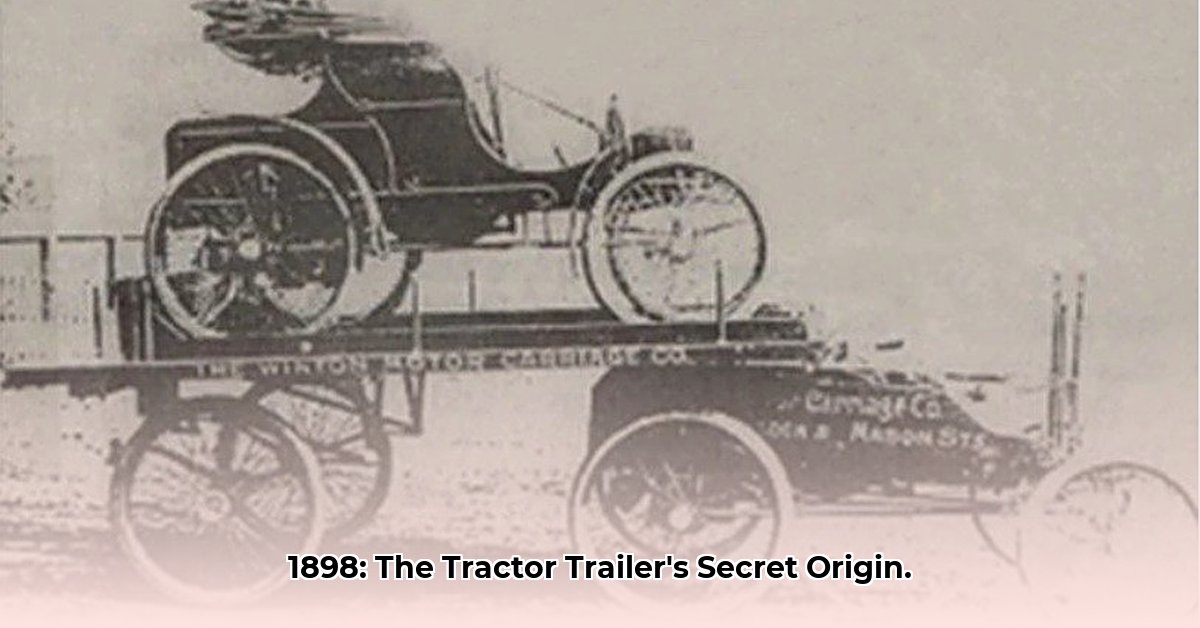
First Tractor Trailer: A Revolution on Wheels
Imagine a world without the rumble of massive semi-trucks – no 18-wheelers delivering online purchases, no long-haul trucks crisscrossing the nation. Hard to envision, isn't it? Before 1898, moving heavy freight was slow, costly, and labor-intensive. That year, however, Alexander Winton's invention irrevocably changed the landscape of transportation: the first tractor-trailer. This wasn't the sleek machine we see today, but a groundbreaking prototype that laid the foundation for a global industry. How did this seemingly simple innovation reshape the world? This article explores the fascinating history of the first semi-trucks and its enduring impact. Did you know that early designs often struggled with unreliable engines and rudimentary braking systems? For more on unique truck designs, check out this amazing site.
The Dawn of a New Era: 1898 and Beyond
The late 1800s saw the nascent automobile industry grappling with a crucial challenge: efficient distribution. Alexander Winton, a forward-thinking inventor, recognized the need for a powerful engine to pull a separate carriage – the very first tractor-trailer. His invention, though clunky by modern standards, was a pivotal moment. It wasn't just a machine; it was a solution to a pressing logistical problem, specifically designed initially for hauling the very automobiles it helped to distribute. Wasn't this early application a stroke of genius?
Early Days: A Rocky Road to Success
The early days were far from smooth. Picture this: rough, unpaved roads, engines prone to breakdowns, and weak braking systems. These were prototypes, constantly refined by pioneers like August Fruehauf, who made significant contributions to trailer design, including improvements in the crucial connection between tractor and trailer. Each incremental improvement, each innovative design fix, paved the way for the efficient transport systems we now take for granted.
Paved Roads and the Interstate System: Game Changers
The advent of paved roads and the later construction of the Interstate Highway System were nothing short of revolutionary. Paved surfaces allowed for heavier loads and faster transit times. The standardized highway designs and the widespread adoption of the fifth-wheel coupling (the pivotal connection between tractor and trailer) transformed the industry. Prior to this standardization, each rig was essentially unique, leading to significant inefficiencies. This infrastructure investment was key to the semi-truck's rise to prominence. Wasn't it an incredible example of infrastructure development supporting commercial progress?
From Logging to Logistics: The Semi-Truck's Ascent
The semi-truck's acceptance was not solely reliant on highway construction. The logging industry rapidly embraced this technology, showcasing its capability to overcome challenges such as hauling massive logs over difficult terrain. This demand fueled innovations – enhanced suspension for heavy loads, more powerful engines capable of handling tough conditions. Military applications played a significant role, with repurposed military trucks boosting the development of durable, civilian-oriented designs. This cross-sectoral cooperation resulted in leaps forward in both technology and reliability.
Evolution of the Beast: From Humble Beginnings to Technological Marvel
The evolution from the initial prototype to today's sophisticated semi-trucks is remarkable. Modern rigs incorporate complex electronic systems for navigation, safety, and fleet management. Engines are far more fuel-efficient and environmentally friendly thanks to technological advancements. This progression highlights continuous improvement in engineering and design. How many technological leaps have allowed the semi-truck to keep pace with our ever-evolving demands?
Legacy of Innovation: The Road Ahead
The first tractor-trailer, a seemingly simple invention, triggered a transportation revolution. It's a story of resilience, resourcefulness, and constant refinement. Today's semi-trucks are indispensable to global commerce. What will the future hold? Autonomous driving and sustainable fuels are already on the horizon, promising further transformations. The journey from that initial prototype to the state-of-the-art vehicles of today is a testament to human ingenuity and innovation.
How Did Military Technology Influence Early Semi-Truck Design?
The semi-truck's history is intertwined with military innovation. Early designs, like Winton's 1898 creation, were basic. The challenge of safely coupling a trailer to a tractor was a serious obstacle.
The Impact of Warfare: World War I dramatically increased the demand for efficient transportation. The military's need for rapid movement of troops and supplies spurred advancements in engine technology, chassis construction, and tire design. Strong materials, initially used in military vehicles, were later adopted by the commercial industry. Military developments in braking technology also improved safety in the civilian sector.
Post-War Advancements: Post-WWI, demand for freight transport soared. Military-driven innovations accelerated the evolution of semi-truck design. The development of the fifth-wheel coupling was a key breakthrough. The US Interstate Highway System further fueled this adoption, promoting long-haul transportation.
Lasting Legacy: Military technology's influence on semi-truck design is clear. From robust engines to enhanced braking systems and stronger materials, the lessons learned in war significantly advanced the trucking industry. The modern semi-truck is a clear example of this enduring impact.
Key Takeaways:
- Early designs were rudimentary, adapted from existing automobiles.
- WWI significantly advanced semi-truck technology, especially in engine and chassis design.
- Military innovation in materials and braking systems greatly benefitted commercial trucks.
- Post-war developments, including the fifth-wheel coupling and the Interstate System, expedited the evolution.
- Military technology's influence on civilian trucking remains significant.